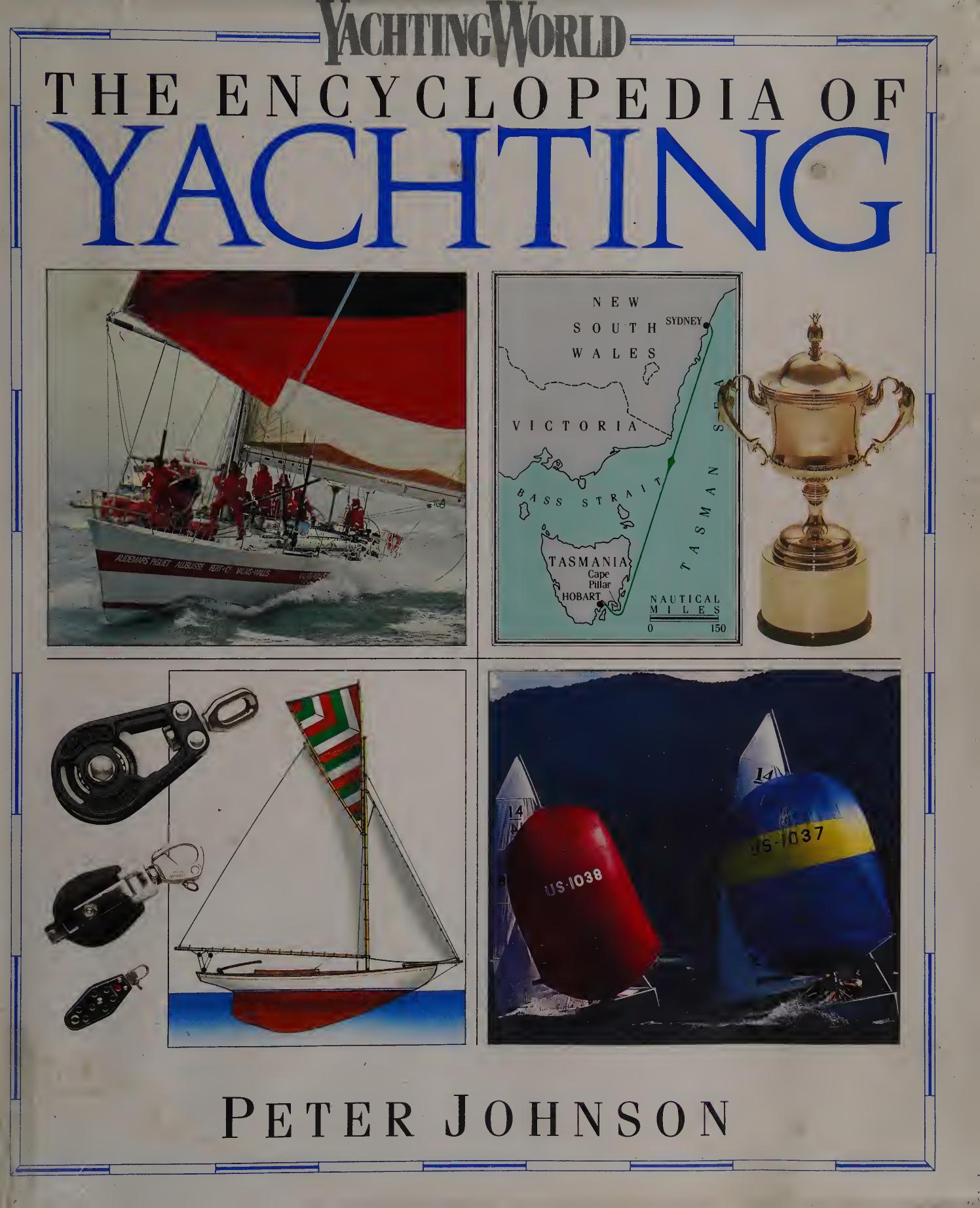The encyclopedia of yachting by Johnson Peter 1930 Mar. 26-

Author:Johnson, Peter, 1930 Mar. 26-
Language: eng
Format: epub, pdf
Tags: Yachts and yachting, Yachting
ISBN: 0863183662
Publisher: London : Dorling Kindersley
Published: 1989-11-15T00:00:00+00:00
YACHT
SKIPPER
Av. SPEED IN KNOTS
mid-C19th
FLYING CLOUD
N/A
15.4
1984
FORMULE TAG
MIKE BIRCH (UK)
21.35
1987
FLEURY MICHON VIII
PHILIPPE POUPON (FR.)
21.5
PASSAGE RECORDS
Since yachts only used to sail long distances exceptionally, there were few recorded passages until ocean races became established in the early years of this century. From the first Bermuda and Fastnet races onwards, the elapsed times have been recorded by the organizing club and a record kept of the best time achieved on the course. These records are detailed for many races in Chapter Three (pp 58-137). Other than those achieved by multihulls, in which speeds of 12 to 16 knots are common, the average speeds recorded by monohulls rarely top 10 knots at the most, and are usually much slower.
It must be remembered that since almost all races use time allowances, the development of the best boats was not along the lines of absolute speed but of speed for rating. This remains the case today, with the crack Admiralâs Cup yachts designed near the bottom of the rating band and so theoretically slower than the potentially fastest Admiralâs Cup boat.
A further point is that in one of the most famous yacht races in history, when America won the race round the Isle of Wight in 1851, no time allowance was in force, and it was thus the fastest boat that won: since the winds were light throughout the race, the actual speed attained on that occasion has never been of interest.
Two factors have combined to change this situation. The first is the establishment of single- and short-handed races, all of which are on a âfirst-to-finishâ basis, thereby focusing interest on the winnerâs time. Yachts are therefore designed to be faster in absolute terms specifically for these races.
The second factor is the development of maxi-raters and multihulls. Yachts built to maximum figures under a rating rule are designed to be first to finish, rather than win a race under corrected time. They thus have every chance of breaking the course record. The whole purpose of multihulls, in their early days, was to show that they were faster than monohulls over a course. This is now taken for granted, but their speeds and therefore elapsed times are the most impressive that exist for sailing boats of any size.
EASTBOUND TRANSATLANTIC _ RECORDS _
The record for sailing fully crewed across the Atlantic in the fastest direction - that is west to east with the prevailing winds was set in the 1905 Transatlantic Race by Atlantic (see p84). Under the control of skipper Charlie Barr, the 56.4-m (185-ft) schooner took 12 days 4 hr 1 min to cross the Atlantic at an average speed of 10.02 knots. She set a record that was to remain unbeaten for 75 years.
Subsequent, fully crewed, transatlantic races with invariably smaller yachts produced no times to beat that set by Atlantic , although Jim Kilroy (USA) came close in 1969 in Kialoa II, taking 12 days 5 hr 43 min to cross from Newport, Rhode Island, to Cork, Ireland (see pp85-6). But by the 1970s, the owners of maxis and other large yachts became interested in the possibility of beating the record.
Download
The encyclopedia of yachting by Johnson Peter 1930 Mar. 26-.pdf
This site does not store any files on its server. We only index and link to content provided by other sites. Please contact the content providers to delete copyright contents if any and email us, we'll remove relevant links or contents immediately.
What's Done in Darkness by Kayla Perrin(25501)
Shot Through the Heart: DI Grace Fisher 2 by Isabelle Grey(18220)
Shot Through the Heart by Mercy Celeste(18160)
The Fifty Shades Trilogy & Grey by E L James(17777)
The 3rd Cycle of the Betrayed Series Collection: Extremely Controversial Historical Thrillers (Betrayed Series Boxed set) by McCray Carolyn(13189)
The Subtle Art of Not Giving a F*ck by Mark Manson(12912)
Scorched Earth by Nick Kyme(11833)
Stepbrother Stories 2 - 21 Taboo Story Collection (Brother Sister Stepbrother Stepsister Taboo Pseudo Incest Family Virgin Creampie Pregnant Forced Pregnancy Breeding) by Roxi Harding(11040)
Drei Generationen auf dem Jakobsweg by Stein Pia(10217)
Suna by Ziefle Pia(10186)
Scythe by Neal Shusterman(9263)
International Relations from the Global South; Worlds of Difference; First Edition by Arlene B. Tickner & Karen Smith(8609)
Successful Proposal Strategies for Small Businesses: Using Knowledge Management ot Win Govenment, Private Sector, and International Contracts 3rd Edition by Robert Frey(8419)
This is Going to Hurt by Adam Kay(7696)
Dirty Filthy Fix: A Fixed Trilogy Novella by Laurelin Paige(6453)
He Loves Me...KNOT by RC Boldt(5805)
How to Make Love to a Negro Without Getting Tired by Dany LaFerrière(5378)
Interdimensional Brothel by F4U(5305)
Thankful For Her by Alexa Riley(5162)
